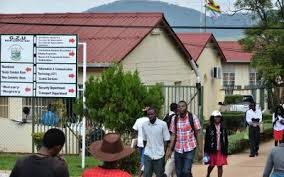THE Structured Dialogue Platform (SDP) meetings on Zimbabwe’s arrears clearance and debt resolution are expected to rstart next month, following a break when the country held its harmonised elections in August, according to the latest public debt report by the Treasury.
In a bid to tackle Zimbabwe’s debt and arrears overhang, the Government established the SDP in December 2022, bringing together creditors and development partners to foster structured dialogue on economic and governance reforms that lay the foundation for arrears clearance and debt resolution processes.
The initiative is being led by acclaimed banker Dr Akinwumi Adesina, president of the African Development Bank (AfDB), while Mozambique’s former President Joaquim Chissano is facilitating the high-level dialogue.
Presenting the 2024 National Budget at the new Parliament building on Thursday, Finance, Economic Development and Investment Promotion Minister Professor Mthuli Ncube noted: “Broadly, (some of) the focus areas and priorities from stakeholders revolve around the following issues: engagement and re-engagement efforts that build confidence and goodwill with external development partners, as well as resolving the external debt arrears, including debt restructuring.”
Zimbabwe’s total external debt as at September 30, 2023 amounted to US$12,7 billion, including liabilities on the Reserve Bank of Zimbabwe (RBZ) balance sheet of US$3,6 billion.
The last meeting on arrears clearance and debt rescheduling was convened in May this year. It involved international creditors and was facilitated by Dr Adesina in Egypt on the sidelines of the AfDB annual general meeting.
While these meetings were temporarily paused, the technical sector working groups continued their efforts to finalise the three policy matrices and implement agreed reforms.
Since December 2022, the SDP has made significant strides, fostering a climate of increasing consensus and confidence in the process, fuelled by a transparent and inclusive consultative approach.
Five SDP meetings have been convened, including a High-Level Debt Resolution Forum held in Harare. These meetings have delved into three strategic pillars — economic, governance and land tenure reforms.
The three sector working groups have since developed the policy reform matrices under the three pillars. The economic reforms pillar is co-chaired by the Ministry of Finance, Economic Development and Investment Promotion, the World Bank and the International Monetary Fund (IMF).
The governance reforms pillar is co-led by the Ministry of Justice, Legal and Parliamentary Affairs and the European Union, while the land tenure reforms pillar is co-chaired by the Office of the President and Cabinet, the United Nations Development Programme and Switzerland.
According to the Treasury report, a comprehensive roadmap has been crafted, outlining the next steps to be taken. This roadmap identifies a range of readily achievable policy actions, referred to as “low-hanging fruits”, which the Government can implement promptly.
These actions form an integral part of the arrears clearance and debt resolution roadmap. These include the successful conduct of free, fair and peaceful elections in August 2023 and the successful completion of an IMF staff-monitored programme.
It also entails implementation of robust measures to combat corruption, the drafting of legislation to provide for transferable and bankable 99-year leases, payment of compensation to former farm owners based on the Global Compensation Deed, and resolution of outstanding bilateral investment protection and promotion agreements (BIPPAs).
The Government requested the IMF to initiate the process in June 2023. The technical work on the SMP has commenced, including a recent IMF mission from October 18 to 25, 2023.
The mission to begin negotiations for an SMP is scheduled to visit Zimbabwe in January 2024, with the SMP anticipated to commence during the first quarter of 2024.
To mitigate impact on vulnerable groups during the SMP implementation period, the Government is seeking a “wet” SMP, which necessitates funding for priority areas such as social protection, education, health, food security and climate change.
The Government has also proactively initiated implementation of reforms outlined in the three policy reform matrices, particularly those within the economic reforms matrix.
This includes policy measures aimed at achieving macroeconomic stabilisation crucial for instilling confidence, bolstering demand for the local currency and fostering market discipline. Furthermore, the Government has engaged the African Legal Support Facility to provide technical assistance in drafting the 99-year lease legal instrument.
This collaboration ensures the instrument meets the criteria of transferability and bankability, as stipulated in the National Development Strategy 1 (NDS1).
“The success of the Arrears Clearance and Debt Resolution process is critical for the country to unlock new external financing, needed to achieve NDS1 development objectives,” the report said.
“The country’s sustainable economic recovery agenda requires the support of development partners and International Financial Institutions, through a comprehensive arrears clearance and debt resolution process.”
The external debt stock decreased from US$12,8 billion in December 2022 to US$12,7 billion in September 2023 due to a reduction of US$684,8 million in liabilities on the RBZ balance sheet.
Out of the total bilateral and multilateral external debt of US$9,1 billion, debt denominated in euros constitutes 31 percent.
The appreciation of the US dollar against the euro from December 2022 to September 2023 resulted in a decrease of US$37,9 million in the bilateral and multilateral external debt component.
However, this reduction was offset by an increase of US$227,6 million in penalties.
An additional increase in external debt stemmed from disbursements, including a US$400 million loan from Afreximbank.
Of the bilateral and multilateral debt amounting to US$9,1 billion, US$7 billion or 76 percent comprises principal arrears, interest arrears and penalties.
Bilateral external debt owed to Paris Club and non-Paris Club creditors stood at US$6 billion, with principal arrears, interest arrears, and penalties accounting for US$4,4 billion.
The five largest Paris Club creditors are Germany, France, the United Kingdom, Japan and the United States, with a combined external debt stock of US$2,9 billion.
Within the Paris Club external debt portfolio, penalties for these five largest creditors account for US$1,5 billion.
China is the largest non-Paris Club creditor, accounting for 95 percent of the total non-Paris Club external debt of US$2 billion.
China’s stock of total external debt at US$2 billion is lower than Zimbabwe’s total debt to the five largest Paris Club creditors.
Non-Paris Club loans, including those from China, were contracted after 2000, while Paris Club loans were taken before 2000, when the country began accumulating arrears. The average interest rate for the external debt portfolio stands at 6,3 percent.
Multilateral creditors average 4,16 percent while bilateral creditors average 4,4 percent.
The average penalty interest rate for multilateral and bilateral creditors is 6,6 and 6,2 percent, respectively.
The highest penalty rate for bilateral creditors is 12,2 percent, imposed by the French COFACE, while the highest rate for multilateral creditors is 10,5 percent, levied by the European Investment Bank.
Source Zimsituation











